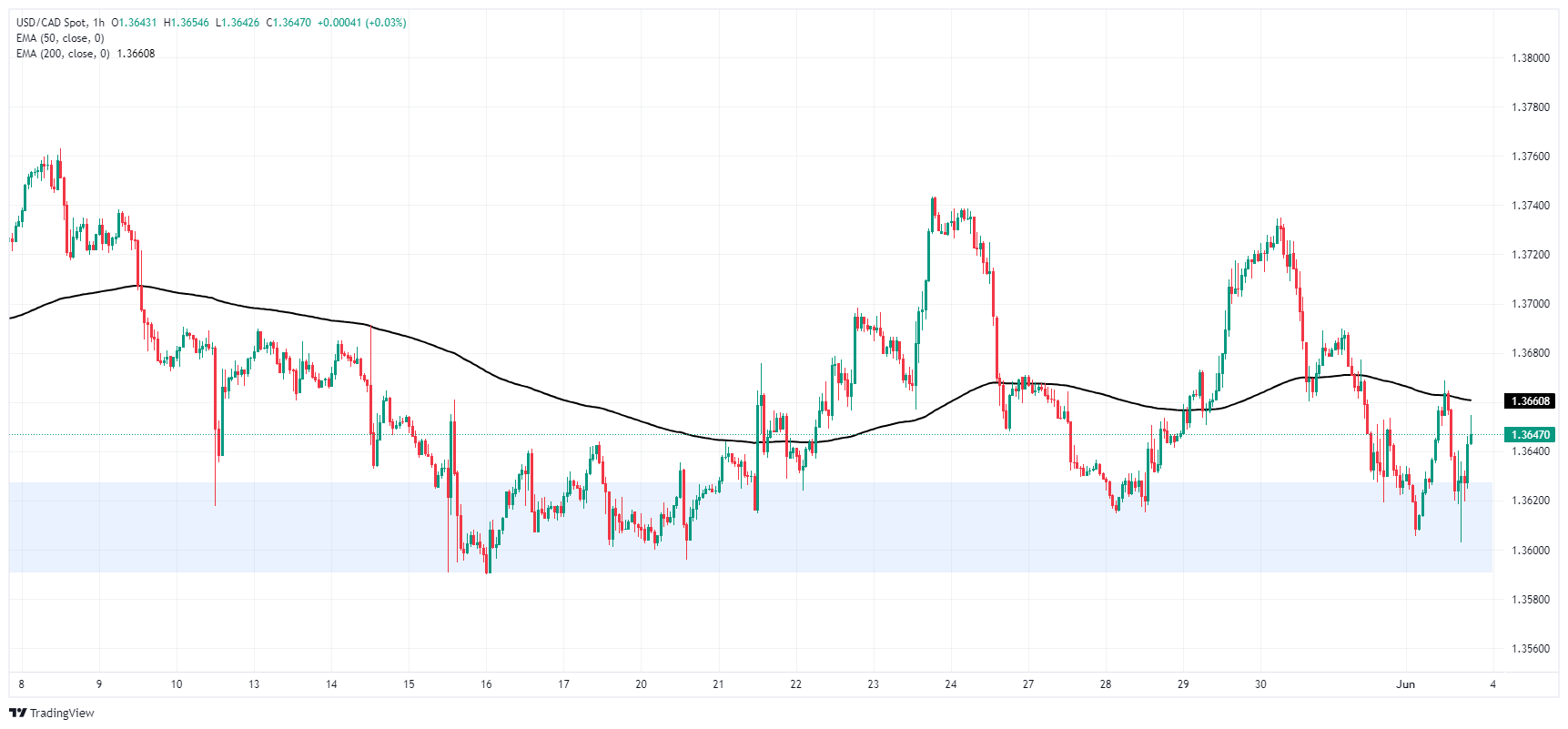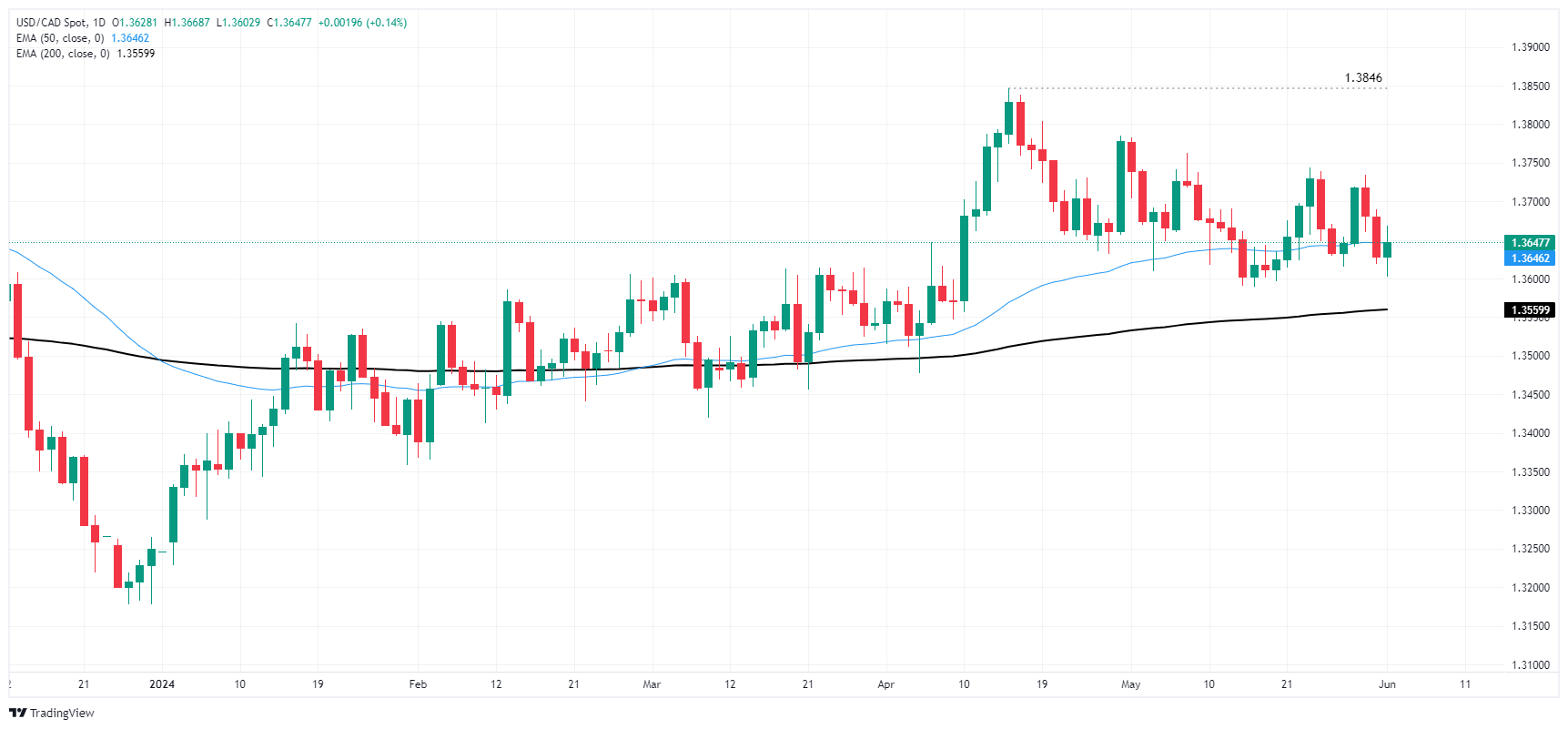Canadian Dollar races Greenback lower after manufacturing PMIs broadly miss the mark

- Markets kick off NFP week pricing in a first Fed rate cut in November.
- Canada reveals unexpected downturn in Manufacturing PMI data.
- CAD traders will be gearing up for a midweek BoC rate call as NFP Friday looms.
The Canadian Dollar (CAD) is broadly lower on Monday after May’s S&P Canadian Global Manufacturing Purchasing Managers Index (PMI) figures missed the mark. A similar miss in ISM US Manufacturing PMIs has left the Canadian Dollar and the US Dollar (USD) battling for second place.
Canada has spent 13 months with manufacturing PMI surveys printing below the key 50.0 level as industry leaders continue to grapple with a mouldering Canadian economy. CAD traders will also be looking ahead to Wednesday’s rate call from the Bank of Canada (BoC) as markets lean further into hopes of a rate trim from the Canadian central bank. According to a recent Reuters poll, 22 of 29 surveyed economists expect a 25-basis-point rate cut from the BoC on June 5.
Daily digest market movers: Canadian Dollar weakens, but Greenback weakens faster
- Canadian S&P Manufacturing PMI in May eased to 49.3 from 49.4, missing the forecasted increase to 50.2.
- Markets broadly ignored the S&P Global US PMI to focus on a miss in the US ISM Manufacturing PMI, which eased to 48.7 from 49.2 in May, down from the forecast increase to 49.6.
- Wednesday looms ahead with the BoC’s latest rate call, where markets are anticipating a quarter-point cut.
- Wednesday also brings ADP Employment Change for May, a common (albeit volatile) preview of Friday’s US Nonfarm Payrolls (NFP) jobs report.
- Canadian labor figures due Friday will be overshadowed by market reactions to US NFP.
Canadian Dollar PRICE Today
The table below shows the percentage change of Canadian Dollar (CAD) against listed major currencies today. Canadian Dollar was the strongest against the US Dollar.
| USD | EUR | GBP | JPY | CAD | AUD | NZD | CHF | |
|---|---|---|---|---|---|---|---|---|
| USD | -0.36% | -0.34% | -0.76% | 0.11% | -0.24% | -0.61% | -0.91% | |
| EUR | 0.36% | 0.05% | -0.41% | 0.46% | -0.01% | -0.25% | -0.56% | |
| GBP | 0.34% | -0.05% | -0.38% | 0.42% | 0.01% | -0.36% | -0.62% | |
| JPY | 0.76% | 0.41% | 0.38% | 0.83% | 0.55% | 0.29% | 0.00% | |
| CAD | -0.11% | -0.46% | -0.42% | -0.83% | -0.38% | -0.72% | -1.03% | |
| AUD | 0.24% | 0.00% | -0.01% | -0.55% | 0.38% | -0.25% | -0.58% | |
| NZD | 0.61% | 0.25% | 0.36% | -0.29% | 0.72% | 0.25% | -0.36% | |
| CHF | 0.91% | 0.56% | 0.62% | -0.00% | 1.03% | 0.58% | 0.36% |
The heat map shows percentage changes of major currencies against each other. The base currency is picked from the left column, while the quote currency is picked from the top row. For example, if you pick the Canadian Dollar from the left column and move along the horizontal line to the US Dollar, the percentage change displayed in the box will represent CAD (base)/USD (quote).
Technical analysis: Canadian Dollar stumbles on Monday despite USD/CAD pumping the brakes
The Canadian Dollar (CAD) is broadly lower on Monday, shedding weight across the board and struggling to hold ground against the US Dollar. The CAD is down around a full percent against the Japanese Yen (JPY) and the Swiss Franc (CHF). A softening Greenback will have to settle for second place on Monday as the declining US Dollar is struggling to catch up to the weakening CAD.
USD/CAD slumped once more into a familiar demand zone near the 1.3600 handle, but firmer bidding on the Greenback side keeps the pair in range of Monday’s early peak near 1.3660. The pair has been in a rough consolidation pattern since the beginning of May, but highs are drifting lower as CAD strength looks set to fade further.
A long-term technical floor is still priced in at the 200-day Exponential Moving Average (EMA) near 1.3560, and USD/CAD appears mired in congestion at the 50-day EMA near 1.3645. A move higher will see the pair grappling with 2024’s peak bids near 1.3850.
USD/CAD hourly chart
USD/CAD daily chart
Economic Indicator
BoC Interest Rate Decision
The Bank of Canada (BoC) announces its interest rate decision at the end of its eight scheduled meetings per year. If the BoC believes inflation will be above target (hawkish), it will raise interest rates in order to bring it down. This is bullish for the CAD since higher interest rates attract greater inflows of foreign capital. Likewise, if the BoC sees inflation falling below target (dovish) it will lower interest rates in order to give the Canadian economy a boost in the hope inflation will rise back up. This is bearish for CAD since it detracts from foreign capital flowing into the country.
Next release: Wed Jun 05, 2024 13:45
Frequency: Irregular
Consensus: 4.75%
Previous: 5%
Source: Bank of Canada
